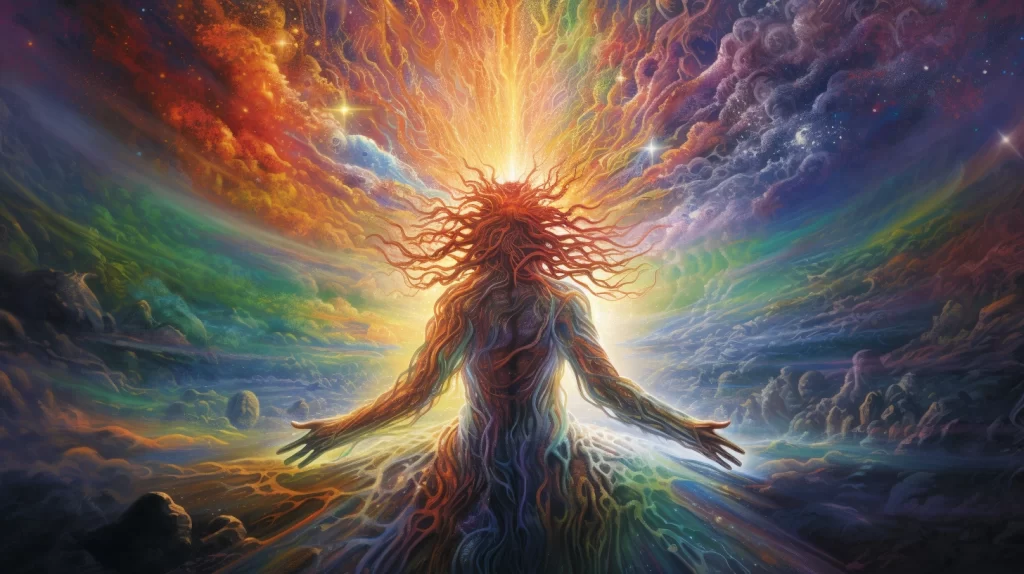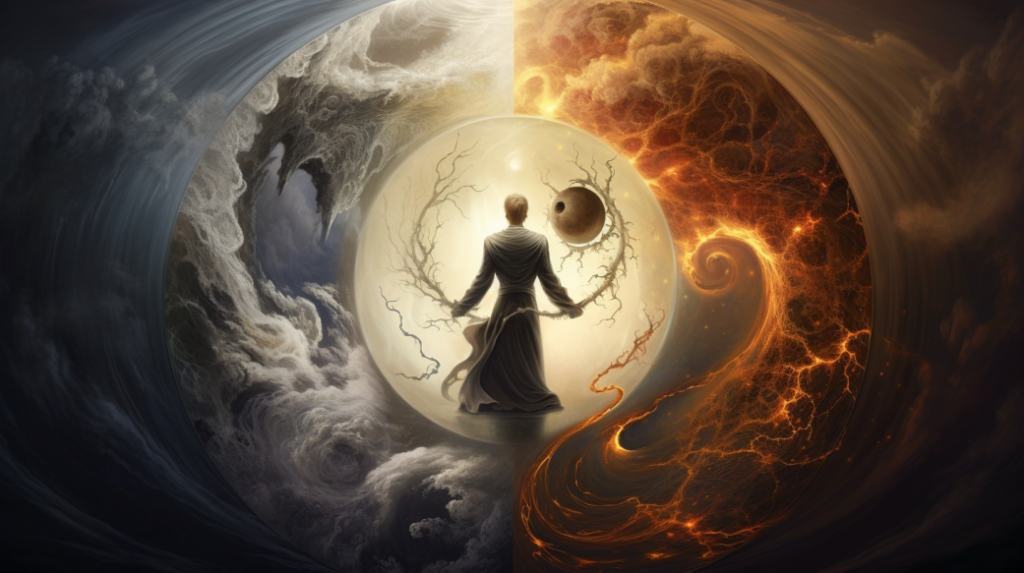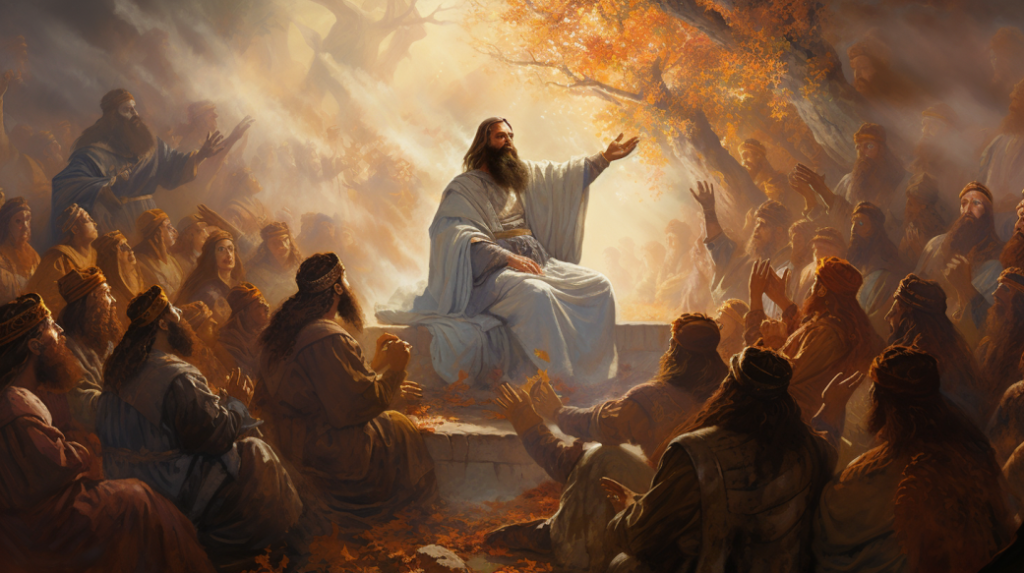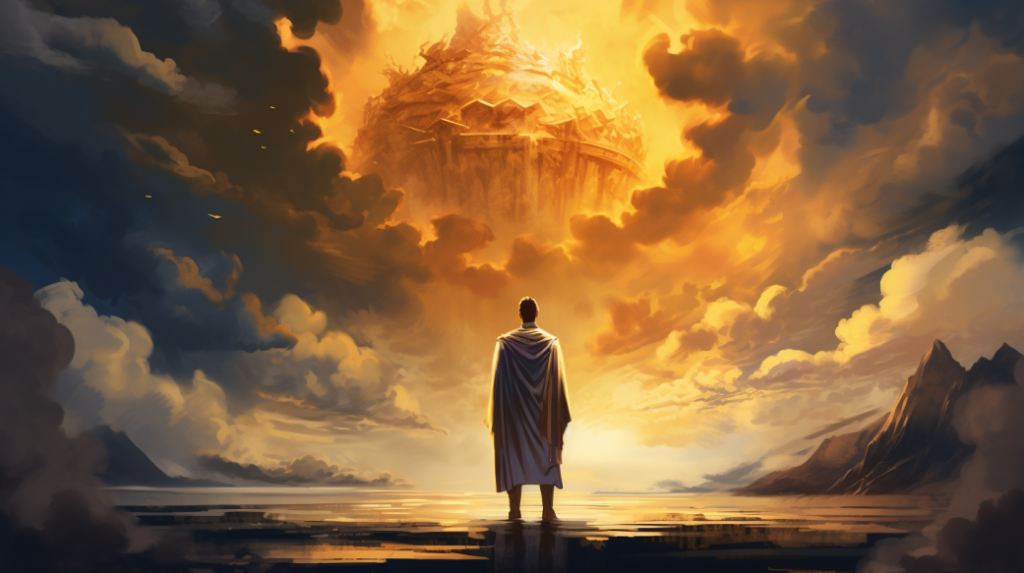
He is at the center, and through this center, he brings Chaos into Order. He channels Divine Will into his own Will. And through this act, the infinite becomes finite, able to be seen by man.
Today, our focus turns to the enigmatic and powerful King archetype, a force that weaves the threads of opposites into a tapestry of self-discovery and societal understanding.
In this exploration, we unravel the layers of symbolism and cultural nuances that give life to the King archetype. It’s more than a mere concept; it’s a living force, inviting us to integrate its energies and find profound meaning in our lives. Join us as we navigate the realms of the King’s influence—acting as a reconciler, a procreator, and a structurer.
This isn’t a distant tale or a detached analysis. No, it’s an invitation to discover the majesty within ourselves. As we venture forward, we’ll witness how the King archetype becomes a blueprint for empowerment, a guide to harmonizing our inner and outer worlds. The throne is calling, beckoning us to explore the depths of our own regal potential.
Before proceeding, I would like to introduce a few quotes to think about as we move forward through the archetype:
Our objective is to develop mature ego structures strong enough to channel useful libidinal energy into our lives.
Moore, p. 36
Splitting is always a symptom of unintegrated development.
Moore, p.38
The king is the archetype that draws the other archetypes together.
Various cultures viewed the king differently. If the king was identified as the embodiment of the archetypal king, the people under him would miss out on the king energy, as they would attribute it to their mortal king. This would lead to some kind of grandiosity. While in other cultures, the king was seen as a servant. The mortal kings had the ability to exercise servant leadership (Moore, p.61)
The archetype is meant to be infused into the person’s ego. It is to be wielded with a blade as an add on.
The King archetype has two different kinds of functions being split into four functions total.
- Introverted Functions
- Reconciler of opposites
- Container of sacred power
- Extroverted Functions
- Procreation
- Structure creation.
Reconciler of Opposites

As a person become more integrated so does his world, both because the perceptions of the world are increasingly accurate, and because the world reveals to him more of its essential nature.
The king reconciles the opposites within himself. He derives fulfillment from uniting the opposites and is in tune with the beauty of such an act. They make the infinite finite, through interpretation of intuition and the actualization of goals. To be able to see both the material and immaterial world and meet them together is a great task assigned to the King.
The ability to make material spiritual, the potential actual, and the unconscious conscious is act of the Reconciler of Opposites. He can live in both worlds and connect them through himself.
Reconciliation Through Marriage
Marriage symbolizes the integration of the masculine and the feminine. In some cultures, the king was being married to the land itself, symbolized by the Queen. The king’s marriage meant a land that was filled with ample opportunity for growth. Psychologically, marriage allows the man to maintain a healthy relationship with himself.
In a union that throws a man’s masculine characteristics into sharp contrast with the feminine, a man can engender an intimate, enhancing relationship with his own Anima. p. 121
With his wife playing the role of the feminine in his life, the man can develop a deeper and intimate relationship with his own feminine. The Queen serves as a projection of his anima and pulls him deeper into his femininity bringing out his more creative and compassionate self. Such a dynamic is essential to understanding the role of romantic relationships in relation to the self, and more topics will be talked about discussing this phenomenon; something important to take away though is that the conscious person is aware of the dynamic between a King and Queen and is consciously working to relate to his own Anima.
A conscious person looking to integrate the King dynamic will find that once he integrates the King, he becomes quite good at using paradoxes to his advantage. Such an act of reconciliation is a depiction of creation itself. To be a king means to bring opposites together, to bring the feminine and masculine together in a marriage, conceiving a child or a concept. (Notice that the word “conceive” and “concept “have the same root word, both related to pregnancy and creation).
The King hangs like a thread connecting the spiritual worlds and the physical worlds. It is through his ability to reconcile the opposites that he serves as the channel between the physical and the spiritual. You will see soon enough that this ability to hang between worlds allows for the other functions to come in, both to transform the psychic energy and to expand it through procreation.
Transforming Vessel
The King serves as a transforming vessel. As mentioned before a good king is able to handle the energies of the King archetype. When one sits on the throne one is sitting in the center of powerful force, one that can terrify those who do not know how to handle it. The King energy is likened to a nuclear energy by Robert Moore, when one comes into direct contact with it, he is bound to get hurt. The energies of the king affected were not something to be taken lightly and there were various cultures that had their own way of containing it.
Moore mentions plenty of examples that illustrate the importance of the containment of this energy. Some of the examples Moore used include the use of the red carpet, the use of isolating rooms for the king, the incestuous marriages that often happened in royal families, and other taboos that regulated the king’s actions. All these actions were methods to protect and contain the king energy.
The outward manifestation of the containment of the King can be directed inwards also. When it comes to an individual managing the king energy, the necessity for a developed ego comes into play.
What is important to note is that the ego is the only structure capable of transforming the energy of an archetype… Ego structure is the psychological equivalent of the shielding and transformer systems noted in ancient ritual and in modern technology.
The ego is the only thing that can serve as a container for the King. The ego is what transmutes and directs the kingly energy into a goal or vision. Without a strong ego the king archetype can overwhelm the psyche and take over. The phenomenon of the narcissist is a clear example of a person who has been overtaken by the king archetype.
This is why it is essential to get to know one’s ego before trying to deal with this archetypal energy. Without having a firm grasp on the functions of the ego, a person will not know how to detach from the archetypes and use them to his advantage. More on the ego will be talked about in the future, but for now, lets continue on the functions of the king.
The King as Procreator

Procreation in Marriage
The procreative function of the king is an extroverted one. This is where the king energy is directed outwards towards his people and the world.
The act of procreation is an act of the extension of the libido. To make the immaterial concrete. The process of solidifying one’s consciousness into reality. Such an act is exemplified by the culture as many people have a large attachment to sex. In modern culture many men attach their self-worth to sex, the more sexual partners they can acquire, the more manly they are. Such a way of thinking is a simpler more primitive manifestation of the procreative function of the King.
We need to understand the meaning of a having a partner and having sex. In anthropology, the main reason humans get married is for the safety of a child. Human beings are the kinds of mammals that need both parents to survive and so evolution led to marriage as one of the safeguards of children’s survival. So, it is essential to know that a King’s marriage and procreative powers were not to be wasted purely on pleasure and promiscuity, the King’s procreative powers were meant to ensure the safety of his kingdom. When a child was born out of the union of the King and Queen, it was considered a sign of prosperity for the kingdom.
Procreation in Blessing
But procreation does not have to be a sexual act as it also exists in a spiritual dimension. The act of giving one’s blessing also serves as an extension of the king. Ancient cultures would believe that the king would “imbue their subjects with souls”, the king accomplished this by seeing them embracing them and blessing them. Below is a list of the 5 aspects of a blessing to further understand this function of the king:
The five aspects of a blessing:
- Meaningful touch
- Spoken blessing.
- Attachment of high value to the other
- Picturing for the other a special future
- An active commitment to the other to help realize that future.
The King archetype is very similar to the father archetype. A good king is a loving king, he blesses his people and is committed to their growth. A good king knows that as he uplifts his people, he also uplifts himself and his kingdom. A good King knows how to bring the best out of people.
Speaking of the father archetype, Moore highlights the power of blessing by explaining how it affects a child’s development. Robert Moore says that the act of seeing a child is essential to their own development. The involvement of a parent during child’s growth serves as a reflection for further development of the child. Without any involvement the child does not know how to operate in the world and will find it difficult to gain a strong understanding of himself and his place in the world.
Procreation in Work
Another act of creation is the work or art that the king reproduces. Every creative act is an extension and expression of the king’s libido. To create a business or a work of art are all acts of procreation, as these things are things that extend his kingdom and his reign. The more a king works, the more he extends himself, such a thing can be attributed to him creating his legacy.
Moore explains that the act of creation is seen as a sacrifice.
He sacrifices the whole of his creative Self for the purpose of realizing a fragment (Moore, 132).
There is an exchange that happens in the creative act also.
He is transfigured by a fresh upwelling of ecstatic life-force through the incomparable experience of empowerment that any successful creative achievement brings (Moore,133)
Being tuned in to his creative powers is something that allows the man to know himself and his abilities. To know the generative energies that run into him and actualize the image that is contained within him is an act of self-empowerment and self-expansion. The more the King creates, the more he brings of himself into the material world to be seen.
The King as Structurer
The King is the one who brings order to chaos. He shapes chaos into a tangible order. A few examples of this function are:
- The king brings order to society through law and custom.
- He communicates with the minds of Gods to bring his people metaphysics and theology.
- He institutes hierarchical levels in his society
Such acts are expressions of the structurer function of the king. One can then start to see how important the structurer function is in one’s individual life. To be able to bring order to one’s inner kingdom is one of the greatest gifts the King archetype can offer once integrated. How many people are going through their lives without any sense of themselves? The king brings order to the psyche and allows for the clarity of self.
We know that it takes tremendous efforts to become conscious. To do this we must build psychological structures (Moore, p. 143).
Consciousness is meant to be a structured thing if it is to be expressed coherently. A cohesive expression of consciousness requires both an understanding of one’s inner systems and an understanding of outer world phenomena. The school system teaches us more about the outer world phenomena and it is the place of “self-reflective disciplines, such as psychology or…spiritual traditions” to teach us about the structures of the inner world and the dynamics of the psyche.
As one tunes in to his own inner world and the structures that lie in there, he is using the King archetype to bring order to his own consciousness. One has to think – how can a man’s outer kingdom flourish when his inner kingdom is a mess? We must start first inwards, and then the outer world will shape itself according to our own consciousness. The need for the structuring function of the king is more prevalent in today’s day and age than ever before.
One look at today’s culture and we can see the byproduct of a structureless psyche. There is a mental epidemic going on and society sees a neurosis such as an addiction as normal. Many people are walking around not knowing the neurosis hidden in their addiction to porn, sugar, weed, tobacco, or coffee. Not to mention the prevalence of the Tyrant King seen in the high number of narcissists walking around in our society.
The disorder in our world is the byproduct of disorder in the mind. Health can be defined as being in harmony with all aspects of life. By this definition, we can then see that the presence of a structurer is essential not only to our mind but to our lives in general. The King harmonizes our psyche and therefore allows for the harmonization of all of our spiritual energies.
It is the king archetype that allows for the differentiation of our own consciousness. Without the king archetype, we are not able to raise ourselves out of our own unconsciousness. The King is the way to an individuated and capable self. The King serves as the center and allows for the other archetypes to flow into a coherent force and controlled force. The king archetype provides the structure and the blueprint for a boy to become a man.
Conclusion

As we conclude our expedition through the corridors of the King archetype, it’s abundantly clear that this majestic force isn’t a relic of tales or a myth in the distance. Rather, it’s a pulsating energy within, beckoning us towards integration, equilibrium, and purpose.
The King archetype, with its role as a reconciler of opposites, a transforming vessel, a procreator, and a structurer, serves as a blueprint for personal growth and societal harmony. It’s not a mere concept; it extends a profound invitation to unravel the majesty nestled deep within ourselves.
In the fabric of our lives, the throne of the King archetype eagerly anticipates our conscious presence. As we weave its energies into our being, we embark on a journey of self-discovery, empowerment, and the harmonization of our inner and outer realms.
So, fellow seekers, heed the call of the throne within. Allow the King archetype to guide you towards a more profound understanding of self, a purposeful alignment with higher forces, and the creation of order amidst the chaos. The majesty is yours to uncover, and as you do, witness your own kingdom flourishing.
Until our paths intertwine again on this expedition of self-discovery, remember, the King within is not a distant ruler but a sagacious and benevolent guide on the path to a more conscious and empowered self.
May your inner kingdom thrive, and may you reign with wisdom and grace.